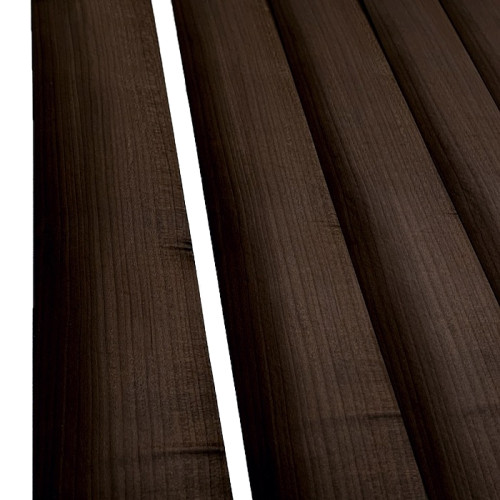
Dark Chocolate Brown Pearwood Veneers 50 x 10 cm
Dark Chocolate Brown Pearwood Veneers 50 x 10 cm
Deep-dyed Genuine wood-sliced veneer sheets.
Length: 50 cm.
Width: 10 cm.
Thickness: 0.6 mm.
Sold by the sheet.
Pictures herewith are photos of the product you will receive.
Dark Chocolate Brown Pearwood Veneers 50 x 10 cm
Deep-dyed Genuine wood-sliced veneer sheets.
Dimensions:
Length: 50 cm.
Width: 10 cm.
Thickness: 0.6 mm.
Measurement scaling:
Dimensions are measured at the small end.
- Width rounded to the covered centimeter: 15.8, giving 15 cm.
- Length rounded to 5 centimeters: 257, giving 255 cm.
Deep-dyed veneers:
Tinted in the mass, deep-dyed veneers allow sanding the veneers after gluing to keep the color.
After sanding, colors will be palish but regain full intensity after finishing.
We limit our environmental impact by using alimentary and natural dye products. We chose that the colors might be different from those using chemicals.
Our production is made in France with wood grown and sliced in France.
Product Description:
Genuine wood-sliced veneer sheets.
These veneers are raw without a finish or any fleece back.
The veneer surface is similar to plane wood. However, it will be preferable to forecast a light sanding after gluing.
The veneers are offered here as wood-sliced sheets of one and unique thickness.
Both faces of these veneers are the same, without fleece back or glue.
Even if the veneer's sides had been cut relatively straight, it isn't a precise parallel clipping, and some veneers may have kept the decreasing shape of the tree, wider at the bottom end and narrower at the top end.
Some veneer sides occasionally have unclipped wane traces, but our veneers are measured at the narrowest, as explained in the paragraph dimensions.
As genuine natural wood, all finishing products are acceptable as long as they are meant for wood usage.
The choice of the finished product must be consistent with the final usage realization.
The Species:
Botanical name: Sorbus torminalis.
Common names: Pearwood, Peartree, Swiss pear, Checker tree.
Pearwood is often the trade name for this wild forest pear tree, also called the checker tree.
Pearwood has been used in cabinetmaking and marquetry from the 17th century to the present to create refined decorations.
Although this wood is dense, working with it is pleasant. It offers a firm and very soft texture, almost velvety to the touch.
Its natural color is creamy white, but steaming it renders it salmon-colored, which, with a colorless varnish, will give it a shimmering Venetian blonde appearance.
Pearwood is one of those rare woods whose color improves over time, gaining depth and shine.
Pearwood is a prime candidate for being dyed black, thus offering a black ebony substitute.
Utilization:
Cutting:
Veneers can be easily cut with a utility knife.
For straight cuts, the best results are obtained with a veneer saw.
Use a fretsaw, scalpel, or veneer knife for curved cuts.
Always allow for a slightly larger veneer sheet than your intended surface. This will allow you to adjust the size after gluing for a clean finish.
A flush trimmer can also be used to trim the veneer after gluing.
When cutting with a utility knife or veneer knife, it is best to cut with the grain of the wood. To check this, run your finger along the edge of the sheet. The direction that feels smoothest is the ideal direction for cutting.
Gluing:
Several types of gluing are possible.
With vinylic glue, the veneer is pressed over its entire surface.
With neoprene glue, apply two coats of glue and marouflage for all surfaces, especially non-porous surfaces.
With animal glue such as hide, sinew, or bone glue.
With vinyl glue and an iron, apply two thin coats of glue to each piece. This technique should only be used if other gluing techniques are not possible.
Sanding:
Veneers and all our products are wood and can be sanded according to their thickness.
Regardless of the thickness of the veneer, please do not use a belt sander, as this could pierce it.
With a 0.6 mm veneer, lightly sand with 120 grit and then finish with 180 or 240 grit. With an orbital sander, 180 grit is already sufficient for most applications.
Finishing:
All finishing products generally used for wood are suitable for finishing our products. For example, you can use a varnish, wax, paint, or oil.
However, ensure that the product you want to use is compatible with the final use of your creation.
Look at our TUTORIALS, and you might find some valuable tips.
Photos:
Pictures herewith are actual photos of the product you will receive.
Although we strive to take photos with a color as close to reality as possible, they are only photos whose hue may appear slightly different from reality; the screen on which the photos will be viewed also affects their appearance.
One of the photos shows the color of the wood after sanding and varnishing.
The sanding was done mechanically at 120 grit.
The varnishing is done in 1 or 2 coats with a colorless polyurethane varnish (cleaning the tools with white spirit/acetone).
Packing:
Veneers are rolled and well protected in a strong carton chosen to resist somewhat vigorous handling and delivered to you in good condition.
More information:
If you need more information, please contact us by email or phone.
Data sheet
- Species
- Pearwood
- Grade
- Quarter-cut
- Color
- Black
Brown
 English
English




